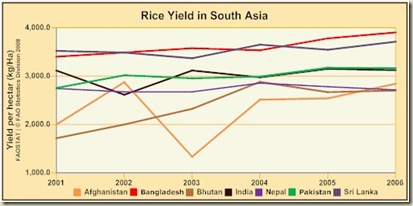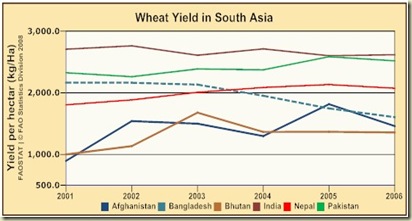The World Bank's South Asia section has a nice analysis of the impact of rising food prices in South Asia, where at least 75% of the population live in rural areas and 60% of the labor force depend on agriculture. Crop yields have declined from 2.1 percent a year between 1950 and 1990 and to 1.2 percent after 1990. The WB believes that technology has the answer to slacking yield in the region.
"Organizing and providing economy of scale to small producers will significantly reduce the cost of doing business in rural areas and facilitate their integration into value chains. This will transform small farmers into an attractive market with greater bargaining power in dealing with the public and the private sector," said Brizzi. While these investments will not affect food prices in the short term, they can help to achieve food security in the future.
...Brizzi attributed the increase in the world food prices to raising standards of living in countries like China and India, increased use of food crops for bio-fuels, and increased oil and fertilizer prices. The major grain exporting countries such as Australia has experienced a substantial drop in its production due to weather-related shortages. Increasing demand for meat and protein diet, which requires more input than cereals, in the developing countries have added a new dimension to this phenomena. Also the high international oil price has accounted for increased fertilizer and transportation costs. More analysis is required to determine the impact of these changes on world food prices.
...Brazil currently does not provide subsidy support to the bio-fuel industry. Brizzi, however, warned that Brazil success story will not necessarily apply to South Asia. He pointed out that sugarcane is a water-intensive crop and in Brazil it is largely rain-fed in contrast India, which is mostly based on irrigation. The feasibility of producing fuels with other crops still needs validation in South Asia.
Btw, Will Martin and Marcos Ivanic from the WB has a nice, interesting, and revealing paper about the impact of rising food prices on poverty. The paper is titled "Implications of higher global food prices for poverty in low-income countries."
Summary:
In many poor countries, the recent increases in prices of staple foods raise the real incomes of those selling food, many of whom are relatively poor, while hurting net food consumers, many of whom are also relatively poor. The impacts on poverty will certainly be very diverse, but the average impact on poverty depends upon the balance between these two effects, and can only be determined by looking at real-world data. Results using household data for ten observations on nine low-income countries show that the short-run impacts of higher staple food prices on poverty differ considerably by commodity and by country, but, that poverty increases are much more frequent, and larger, than poverty reductions. The recent large increases in food prices appear likely to raise overall poverty in low income countries substantially.

